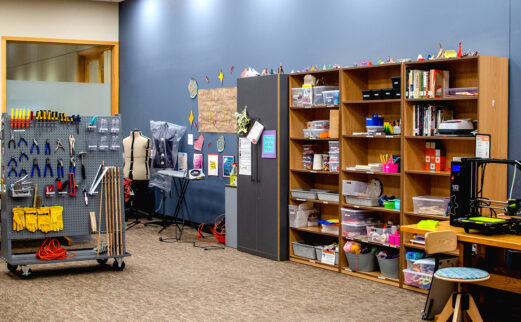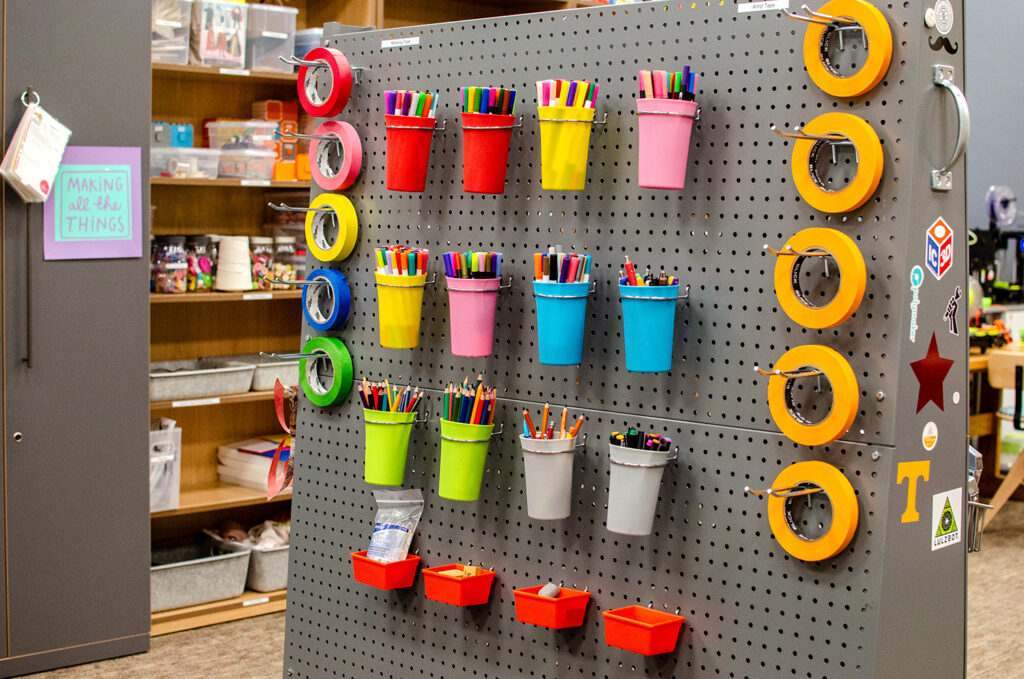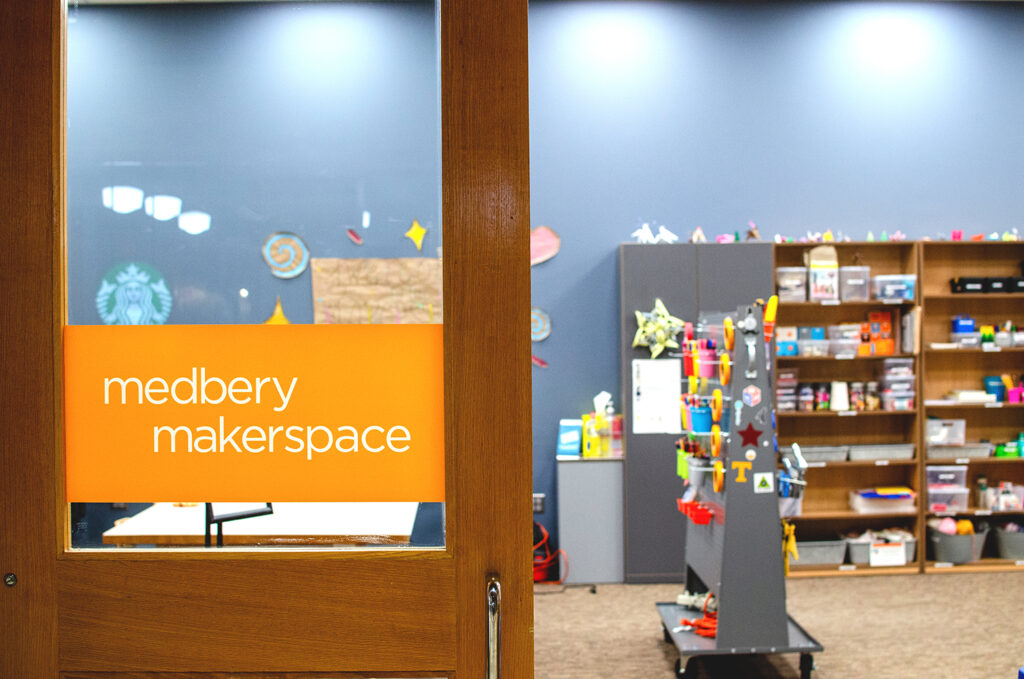

Since it opened in February 2024, the Medbery Makerspace has swiftly become a dynamic space in Hodges Library, providing students with exceptional opportunities for hands-on learning. This unique facility fosters a collaborative environment where students from diverse disciplines can converge, explore, create, and bring their ideas to life. Offering access to tools and guided by knowledgeable makers, the Medbery Makerspace not only supports technical skill development but also facilitates the formation of a vibrant community. Students can transcend traditional academic boundaries, collaborating with peers from engineering, the arts, business, and other fields. That interconnectedness sparks new perspectives and innovative approaches, enriching their educational experiences and preparing them for future careers in a rapidly evolving world.
The vision for the Medbery Makerspace emerged several years ago, before the pandemic, as part of a broader initiative to integrate creative technologies and hands-on learning opportunities within the libraries. The journey from concept to creation was not without its challenges, and the project encountered numerous delays due to external circumstances, shifting personnel, and evolving priorities within the Libraries. Despite those setbacks, the commitment to providing a space where students could engage with maker technologies and collaborate across disciplines remained strong.
The need for dedicated staffing in the makerspace brought an additional hurdle: a limited budget that allowed for only a small team of student workers. Nevertheless the project forged ahead in 2023 with a cross-departmental makerspace team, hiring four new student employees and cross-training existing student library assistants from The Studio, the Libraries’ media and design lab. The group worked tirelessly to set up the space, develop procedures, and gain proficiency with equipment such as sewing machines and 3D printers. The collaborative nature of the team allowed for the sharing of knowledge and skills.
The Makerspace Launches
To build anticipation for the makerspace’s grand opening in February, the staff hosted several pop-up events during fall 2023, including button-making activities and a highly successful bracelet-making event during Homecoming. Those events generated excitement and provided a sneak peek into the creative possibilities that the makerspace would offer.
As the team prepared for the official opening, they established policies aimed at fostering an inclusive and creative environment. Central to the approach was the “free to play” philosophy, which allows students to engage with maker technologies without financial barriers. For instance, students receive 24 free button pins each semester to use with the makerspace’s button-making machines. After that, they can purchase additional supplies while continuing to use the equipment. The policy ensures that all students, regardless of their financial situation, have the opportunity to explore and create.
The team also implemented a user agreement outlining basic safety requirements and user responsibilities. An emphasis on maker literacies means providing hands-on access to equipment, empowering students to learn how to operate machines like 3D printers independently. Rather than simply submitting 3D files for staff to print, students are trained to load filament and start prints themselves. This approach builds students’ technical skills and fosters a sense of ownership and pride in their creations.
Encouraging interaction and collaboration among staff, student employees, and patrons is another cornerstone of the Libraries’ makerspace philosophy. That engagement has already led to the development of a community of makers who return regularly to work on new projects and share ideas.
Tools, Resources, and Certification Programs
The makerspace is equipped with tools and resources across four primary areas:
Arts and crafts supplies including paper, jewelry-making tools, glue guns, and air-dry clay
Textiles equipment and supplies including sewing machines, an embroidery machine, knitting and crochet supplies, basic materials like thread, and donated yarn and fabric
Basic hand tools and electronics repair kits
Fabrication equipment including multiple small 3D printers, a Cricut vinyl cutter, and button makers
The proximity of The Studio to the makerspace creates an environment where students can seamlessly integrate their creative projects. For example, a student group recently used the makerspace to create props for a class project that was later filmed in The Studio’s video production room.
In addition to offering hands-on experience with equipment, the makerspace has implemented equipment certification classes for 3D printers, sewing machines, and the Cricut machine. Those classes are the first step in developing a digital badging and certificate program that will formally recognize students’ maker literacies. As the program expands, it will offer students a valuable credential to demonstrate their skills and experience.
Engagement and Future Plans
The makerspace has already garnered significant interest since its launch. Many classes and groups have scheduled tours, and in April 2024 classes began requesting activities there. An Italian class led by Distinguished Lecturer Renée D’Elia-Zunino integrated the makerspace by having students create Italian-themed buttons. The makerspace staff prepared by providing a selection of books featuring Italian artists, designers, architecture, food, and culture to inspire students.
Reflecting on the experience, D’Elia-Zunino said, “My students of Italian completely enjoyed the makerspace experience last semester! Tying the button-making activity into their final oral exams was such a success! Students proudly wore their pins and presented their topic by showing off their artistic renderings. Making specific books available to them as they arrived was perfect and such an inspiration. . . . They were allowed to concentrate on the Italian culture through their topic and choose to define it with one symbolic image to wear on a button. This taught them to think critically and to channel their thoughts, allowing them to use the language in a different form and expression.”
The summer months have also proven to be a busy time, with engagement from K–12 programs like 4-H and the Freedom School. This increased activity during the summer has highlighted the potential for the makerspace to become a year-round hub of creativity and learning.
Plans are already underway to hire a makerspace manager to further coordinate and enhance the work being done by staff and student assistants. The team anticipates increased collaboration with other library departments, such as an upcoming project in partnership with Special Collections for an English class to explore and create zines—miniature personal magazines. The development of the maker literacies badging program will provide new opportunities for collaboration with other makerspaces within the university community.
Most importantly, the team looks forward to supporting and showcasing the incredible creative work that students will produce in the Medbery Makerspace. By continuing to facilitate creativity, experimentation, and making, they are working to inspire and empower the next generation of innovators and makers.



